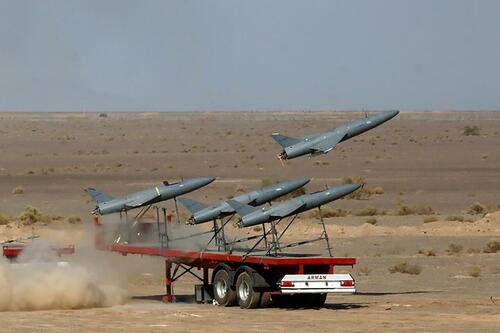Iran Sending More Missiles & Drones To Russia Despite West’s Sanctions Threat
Allegations of increased Iranian military weaponry transferred to Moscow for use in Ukraine has brought the Islamic Republic under greater EU and US scrutiny, as both begin moving toward imposing fresh sanctions on Tehran as they gather evidence.
Reuters is reporting Tuesday that a deal for surface-to-surface missiles has been made, along with more drones, citing a handful of unnamed top Iranian officials. The outlet said in an exclusive, “A deal was agreed on Oct. 6 when Iran’s First Vice President Mohammad Mokhber, two senior officials from Iran’s powerful Revolutionary Guards and an official from the Supreme National Security Council visited Moscow for talks with Russia about the delivery of the weapons.”
One of the Iranian officials told Reuters, “The Russians had asked for more drones and those Iranian ballistic missiles with improved accuracy, particularly the Fateh and Zolfaghar missiles family.”
The West has long worried that Russia would turn to unsavory “rogue” states to resupply its fast depleting munitions for use in its Ukraine assault. This past week in particular has seen Russia for the first time rely heavily on repeat drone strikes on the Ukrainian capital of Kiev and other major cities.
On October 10, when this latest round of widespread Russian aerial bombardment began, Ukrainian President Volodymyr Zelensky denounced in particular the Kremlin’s alleged reliance on foreign ‘suicide drones’. “We are dealing with terrorists,” Zelensky said in those remarks. “Dozens of missiles, Iranian Shaheds.”
With news of a fresh impending weapons transfer between Tehran and Moscow, the EU is reported to be moving toward new sanctions preparations. In the background is also the stalled JCPOA nuclear deal, already unraveling, but a new round of sanctions could prove the final death blow. According to a press briefing by the EU’s foreign affairs chief:
“We are following very closely the use of drones. We are gathering evidence, and we will be ready to react with the tools at our disposal,” EU’s chief diplomat Josep Borrell told reporters after the ministers’ meeting. “These [sanctions] processes have to be based on evidence. Evidence exists; it has been provided by the relevant intelligence services,” Borrell said.
“Once all the evidence is available, and there is a lot already, I don’t think there will be any problem with future steps taken by member states,” he added.
The US State Department chimed in on Monday, with spokesman Vedant Patel saying, “Earlier today our French and British allies publicly offered the assessment that Iran’s supply of these UAVs (for) Russia is a violation of U.N. Security Council resolution 2231.” Patel added in the press briefing: “This is something that we agree with.”
If the West imposes further sanctions on #Iran, what stops #Tehran from supplying #Russia (if not yet supplied) the Arch-1 and Arach-2, the long-range and biggest Kamikaze drone in the world to be used in #Ukraine? pic.twitter.com/9bnuhnKq6a
— Elijah J. Magnier 🇪🇺 (@ejmalrai) October 17, 2022
This indeed suggests that new sanctions are just around the corner. Tehran for its part has expressly denied that it has been supplying drones or other advanced weaponry to Russia for use in Ukraine, while the Kremlin has kept silent on the charges.
Starting in August, The Washington Post, The Associated Press, and others began reporting that the first Iranian shipment of Shahed drones were en route to Russia’s military. Numerous widely circulating social media videos out of Ukraine strongly suggest that some unknown number of Shaheds have indeed been deployed.
* * *
Below: state media footage showing off Iran’s significant ballistic and surface-to-surface missile arsenal…
⚡️⚡️Now that it’s confirmed, I want to share with you this video showing how accurate and powerful the missiles supplied by Iran to Russia are. pic.twitter.com/0qB48rwKZs
— War Monitor (@WarMonitors) October 18, 2022
Tyler Durden
Tue, 10/18/2022 – 12:26

